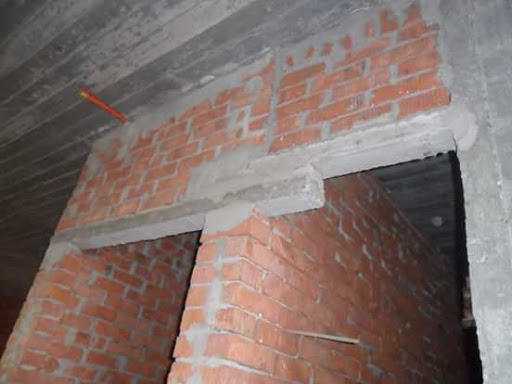The art of covering the surface of masonry work with a suitable material is called plastering. A fine paste of mortar made by mixing cement with sand or fat lime with sand or surkhi in addition to sufficient quantity of water if called plaster.

When cement is used as a binding material, the plaster is called cement plaster and if lime is used as the binding material, it is called lime plaster. An ideal plaster should be smooth, non absorbent and washable. It should not be affected by weathering agencies.
The finished surface of walls constructed in bricks or stones are generally so coarse textured that they provide unsuitable finish for the internal walls of most of the buildings. These surfaces are rendered smooth by the application of one or two coats of plaster. The ceilings are also rendered smooth with plaster.
The object of external plastering is to cover the surface to enable it to resist the effect of weathering agencies. However, a good brick work made of sound, well burnt bricks or neat stone masonry constructed of durable stones does not require external plastering.
The object of internal plastering is to provide a smooth surface in which dust and dirt cannot lodge and to form a smooth surface for applying white or color wash, distemper or paint.
Like Us on Facebook!
TYPES OF PLASTERING
Subscribe Us on YouTube!
- CEMENT PLASTERING
The mix ratio of mortar in case of cement plastering depends upon the nature of the work to be plastered.
For rich plastering work at sensitive places (e.g. in side bathrooms, W.C. etc.), 1:3 cement plaster mix is used. For general plastering of walls 1:5 to 1:8 cement plaster mixes are used.
Preparing the surface
Before applying the plaster, the surface should be prepared properly. The joint of masonry are properly raked to a depth of 10 to 15 mm to provide key to plaster. The surface is then thoroughly wetted with water, washed well and kept wet for six hours. When the surface is ready, plaster is applied.
Applying the plaster
Cement plastering may be applied in one or two coats.In case of plastering of single coat, the mortar is dashed against the prepared surface into a uniform thickness with the help of trowel.Wooden screeds 7.5 cm wide and of required thickness of the plasters are generally fixed vertically 2.4 to 3 m apart to act as gauges guides in order to keep the plaster to the required thickness. Careful plumbing should be done in fixing of these screeds.
Surplus mortar is removed with the help of mason’s straight edge and then the mortar is pressed well with a wooden float so that mortar may fill in the joints of the masonry. The surface is then finally polished with a trowel or iron float. The thickness of this coat should not be more than 16 mm.
In case plastering is to be done in two coats the first coat is applied as described above with the only difference that it is not polished. Before applying the second coat, the first coat is allowed to set but it would not become dry and it is also roughened with a scratching tool to provide key to the second coat.
The second coat is then applied in a thin layer not exceeding 3 mm in thickness within 48 hours. It is then well trowelled and rubbed perfectly smooth with the help of a steel float. It is then allowed to set for 2 days and cured for more than 7 days.
Suitability
This type of plastering forms an ideal coating for external finishings. It is also used for internal renderings of common as well as important buildings. It is specially suited for damp conditions i.e. bathrooms, etc.
- LIME PLASTERING
The proportioning of the ingredients of a lime plaster is adopted according to the number of coats to be applied. If the plaster is to be applied in one coat, 1 part of lime to 1.5 parts of sand is used. If two coats are to be applied, the proportion for the first coat is same as above while the second coat consists of two parts of lime and one part of sand.
If three coats are to be applied, the proportion of the third coat consists of 4 parts of lime to one part of sand.In actual practice, all the coats consist of 1 part of lime to 2 part of sand. Thickness of the lime plaster varies from 15mm to 20mm.
Preparing the surface
The method of preparing the surface is same as described in case of cement plastering.
Application of first coat
It is applied by dashing the lime plaster with the help of trowel against the wall surface between the screeds. Plaster is pressed well in the joints. Function of this coat is to fill all the irregularities of the surface. Average thickness of this coat is 10 to 12 mm. It is then left to dry for 3 to 4 days.
Application of second coat
Before applying this coat, the first coat is well washed and scratched over with the edge of a trowel. The second coat is then pressed against the wall with mason’s trowel and rubbed with a straight edge. Thickness of this coat is 6 to 10 mm.
Application of final and finishing coat
This coat usually consists of fat lime which is called lime putty. It is applied on the second coat, made perfectly plain and then rubbed first with wooden float and then with a steel float to polish the surface, It is about 3 to 6 mm in thickness. It is allowed to dry for two days and then the surface is cured for 7 to 10 days.
Suitability
This type of plastering is suitable for internal renderings of buildings. But it is not commonly adopted these days.
- MUD PLASTERING
The wall surface is first prepared as described in case of cement plastering. The mud plaster is then evenly dashed against the wall surface with a wooden float. After 24 hours, the surface is tamped. The function of tamping is to compact the layer and to drive it deep into the joints. It also helps to avoid developments of cracks due to hollows.
After tamping, water is sprinkled slightly and the surface is polished with a steel trowel. A thin wash of cow dung is then given and tamping is done again at the places where small cracks have formed. Finally the surface is given a wash of fine white earth and cow-dung. Sometimes, surface is given a wash of fine earth, cow dung and cement in proportion of 3 : 2 : 1.
Suitability
This type of plastering is done on walls of temporary sheds and country side buildings.
- STUCCO PLASTERING
This is special type of plaster.Stucco is the name given to a decorative type of plaster which provides an excellent finish like that with marble lining. After preparing the surface, stucco plastering is applied in three coats. Each coat should be permitted to dry thoroughly before applying the next coat.
For internal surface, the first coat also known as scratch coat consists of lime plaster 12 mm in thickness.The second coat or brown coat consists of rich lime plastering in 10 mm thickness. The final coat or finishing coat consists of a mixture of very fine lime and white ground stone ( marble or quartz), 3 mm in thickness. It is carefully polished with a bag of linen containing moist chalk in the first instance and then chalk and oil. The surface is then finally finished by rubbing it with only oil as to make it smooth and bright.
For external surfaces, the first and second coats are 10 to12 mm thick and the finishing coat is 3 to 6 mm thick. The proportion of ingredients for the first two coats is 1 part of cement to 3 parts of sand with 10% by weight of hydrated lime. The finishing coat consists of 1 part of cement and 2 pars of sand in which some coloring pigment is added or colored cement is used.
Method of applying this plaster is same as described in case of cement or lime plastering.
Suitability
This type of plastering is suitable for external as well as internal surfaces of buildings to provide an excellent finish.
- MOUGHAL PLASTERING
It is generally applied in two coats of lime mortar by mixing lime, sand and surkhi in the ratio of 4:3:1 along with glue and powdered gull nut. The surface is well wetted and the second coat of about 1.25 mm thickness is applied when the first coat is hardened. The finished plastered surface is kept wet for 3 weeks.
Suitability
This type of plastering is suitable for internal surfaces of high class buildings but it is not commonly applied these days.
















